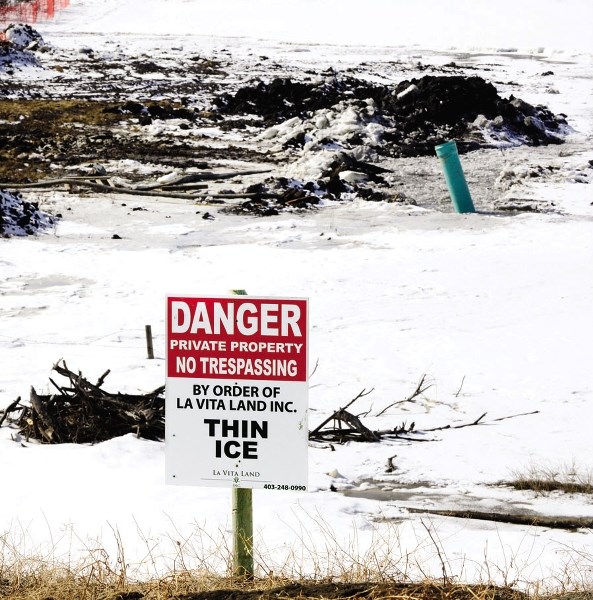As LaVita Land, the developer in the Cochrane community of Fireside, continues to move toward the next stage of Phase Two Fireside development, the harvesting of one wetland, ‘Fireside Wetland #15’ began March 15.
Shortly after they began, concerned members of Save Fireside Wetland (SFW) began a conversation on Twitter – questioning the source of the ‘foul odour’ caused by the harvesting and wondering if it meant that LaVita Land would move forward with the destruction of #15.
“We have talked to Alberta Environment and we stopped pumping into the storm water system,” said Justin Mauro of LaVita Land, adding that the ‘foul odour’ was the result of stagnant water and decaying material (leaves, debris) trapped under the ice.
Once the ice is broken and oxygen hits the material and water underneath, an overpowering foul odour is normal; Mauro said this poses no health and safety concerns — a sentiment reinforced by Kathy Dietrich, senior manager of planning and engineering with the Town of Cochrane.
“We are continuing to harvest ice and black soil from underneath the ice, to be used for rehab of the wetlands in other areas,” said Mauro. “In order to construct in that area (part of Phase Two development) we have to harvest that wetland by April 1.”
“Is this a bonafide environment preservation exercise with this track hoe or some sort of veiled attempt to damage that wetland?” posed Larry Weiers, a resident in the bordering community of Rolling Range Estates and an SFW member.
As far as the destruction of #15 is concerned, Mauro said that they are in line with provincial and municipal guidelines and that the wetland would indeed be removed.
Dietrich said this was part of an overall wetland strategy for the area in 2010, in line with the provincial Alberta Water Act approval of 2011. She also said that there would be ample opportunity for concerned Cochranites and residents to offer input toward the neighbourhood plan for Phase Two; Mauro said he hopes to move into the next phase of development in the coming months.
Cleve Wershler, president of Sweetgrass Consulting Ltd., was contracted by the developer to provide an in-depth report and classification of the wetlands in the Fireside area.
Wershler’s findings resulted in #15 being deemed a ‘class three’ or seasonal wetland, based on historical evidence and the quality of vegetation; his studies were conducted in 2007 and 2008.
According to Wershler, a biologist by trade, LaVita Land has “gone further than some other (developers) would”.
“You look at wetlands over time. Class three, or seasonal, wetlands only refers to the type of vegetation growth and the general water you can expect to be growing.”
Wershler said a number of factors, including the heavy rainfall in 2013, created the impression that wetland #15 is more than just a seasonal wetland, but the type of vegetation and historical trends suggest otherwise.
“What complicated this was when the land was being stripped and graded (during Phase One development) some of the natural flow of the water changed…but there’s a lot more to it than water in a hole.”
Members of SFW question the classification system employed in the process and have appealed the findings in Wershler’s report to the Alberta Environment and Sustainable Resource Development (ESRD) and continue to “await a response”.
Weiers said he and other SFW members are concerned about the remaining wetlands in the area (around 12) that are slated for destruction as development continues.
Mauro said their priority was to harvest #15 by the deadline in order to move forward with Phase Two, but they would possibly get to some of the other, smaller wetlands over the next year.
Mauro said that the three largest wetlands (around 40 in total in the area) have been preserved and that LaVita Land donates money to Ducks Unlimited to preserve wetlands in other locations on a 3:1 ratio.
“That land was zoned for development and you can’t expect every wetland to be preserved,” said Wershler, adding that he is encouraged to see so many Cochranites concerned over the wetlands and encourages them to approach the town for protection and preservation of future wetlands in other areas, earlier on in the process.
To learn more about SFW, visit savefiresidewetland.org.




